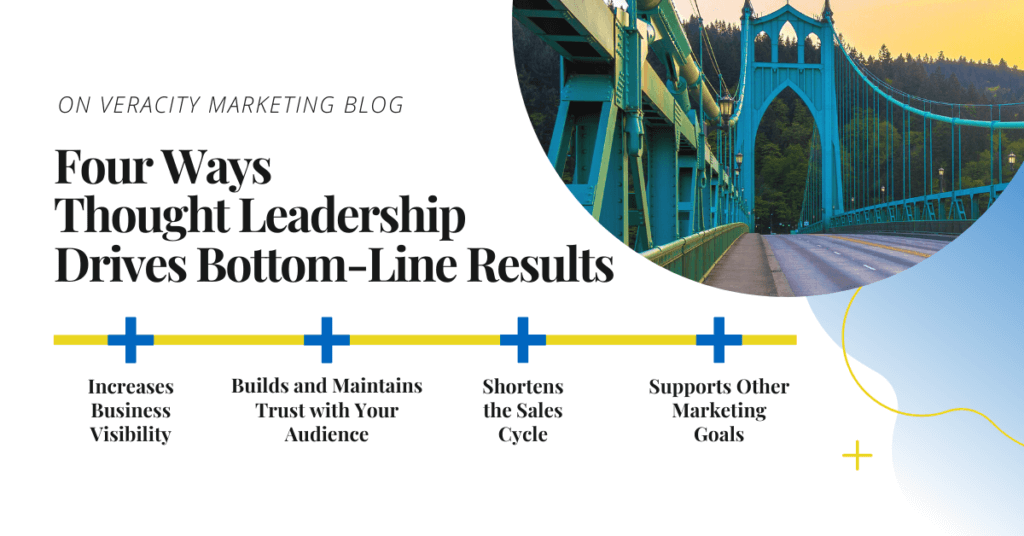Moving Past the Jargon: Why Thought Leadership is an Essential Marketing Tool for Your Business
For a while there, the term “thought leadership” seemed destined for the dustbin of marketing history. Part jargon, part cliche, the term became synonymous with personal brand builders who plied their trade in breathless LinkedIn posts or at TEDx talks held in hotel conference rooms. Fortunately, savvy marketers rescued the thought leader from this ignominious fate by refocusing the concept into a powerful business growth strategy.
Today, thought leadership is a content marketing approach that positions a company, executive or other subject matter expert as the go-to resource in their field. Influential thought leaders produce content that answers their customers’ questions, provides solutions to pressing problems or offers the audience a new point-of-view to consider.
When executed correctly, these campaigns include their own strategies, tactics, goals and measures to judge effectiveness. As those elements come together, thought leadership begins to drive bottom-line results. That’s why marketing leaders — especially in the B2B space — should consider incorporating this approach into their overall strategy.
Four Ways Thought Leadership Drives Bottom-Line Results
While the idea of thought leadership might initially appeal to the ego, it strongly aligns with the marketing philosophy that giving generously to your customers brings tangible returns. Here are four ways that can play out for your business.
Thought Leadership Increases Business Visibility
The goal of marketing is to build awareness around your company and its products or services. By producing thought leadership content, you’ll demonstrate your team’s inherent expertise in ways that are helpful to potential new customers. Research conducted by LinkedIn and Edelman revealed how thought leadership drives new business generation. According to their findings, 45% of decision-makers said they “invited a producer of thought leadership content to bid on a project when they had not previously considered the organization.” After all, delivering an exciting new idea at just the right time is a fantastic way to get someone’s attention.
Thought Leadership Builds and Maintains Trust with Your Audience
By some estimates, acquiring a new customer costs five times as much as retaining an old one. With this in mind, businesses must find ways to grow their existing audience and build the trust necessary for them to purchase again and again. Thought leadership accomplishes this by delivering content that helps customers do their jobs better. According to research conducted by The Grist, 66% of executives use thought leadership to stay ahead of trends. In addition, 60% of executives reported that thought leadership helped them make better, more informed decisions.
When business leaders see smart, relevant and helpful content, it drives behavior. The LinkedIn/Edelman study found that 55% of decision-makers increased their business with an organization based on their thought leadership. What’s more, 60% said that “thought leadership convinced them to buy a product or service they were not previously considering.” These statistics show that well-executed thought leadership campaigns effectively engage existing customers and drive ongoing purchasing decisions.

Thought Leadership Shortens the Sales Cycle
For businesses managing long and complex sales cycles, thought leadership can be an effective strategy for answering questions in advance, preemptively addressing objections and moving customers closer to action. LinkedIn and Edelman found that nearly 60% of decision-makers awarded business to an organization based directly on their thought leadership. By demonstrating your knowledge in advance and anticipating customer pain points, you show potential customers how you’ll serve them once they’ve decided to purchase.
Thought Leadership Supports Other Marketing Goals
In addition to driving customer behavior and bottom-line results, carefully developed thought leadership content becomes flexible assets that support broader marketing efforts like increasing social media engagement, driving traffic to your website and overall brand development. You may also begin to uncover unmet customer needs as you develop audience profiles and mine your organization’s existing expertise.
Potential Thought Leadership Channels
Some companies might hesitate before jumping into thought leadership because they believe they don’t have the expertise to successfully execute their strategy or stand out in a crowded marketplace. However, thought leadership can take on many different forms, including:
- Corporate blogging
- Guest posting on established blogs
- Public relations outreach
- Podcast appearances
- Social media content
- Expert interviews for media
- Conference speaking engagements
- Video content
The key is to assess your organization’s capabilities, find the channels where you’re well-positioned to succeed and then share what you know.
The Recipe for a Winning Marketing Strategy
With this information in mind, it’s easy to see how thought leadership has evolved from an occupation for a specific set of personal brand builders into a legitimate business growth strategy — especially in B2B marketing.
By consistently demonstrating how your unique expertise solves a customer’s specific problems, you’ve positioned your organization as their essential partner for success. Creating that communication ecosystem drives new business leads, accelerates your sales cycle and strengthens existing customer relationships. All the while, you’re creating flexible content that supports other outreach initiatives. That has all the makings of a winning marketing strategy.









